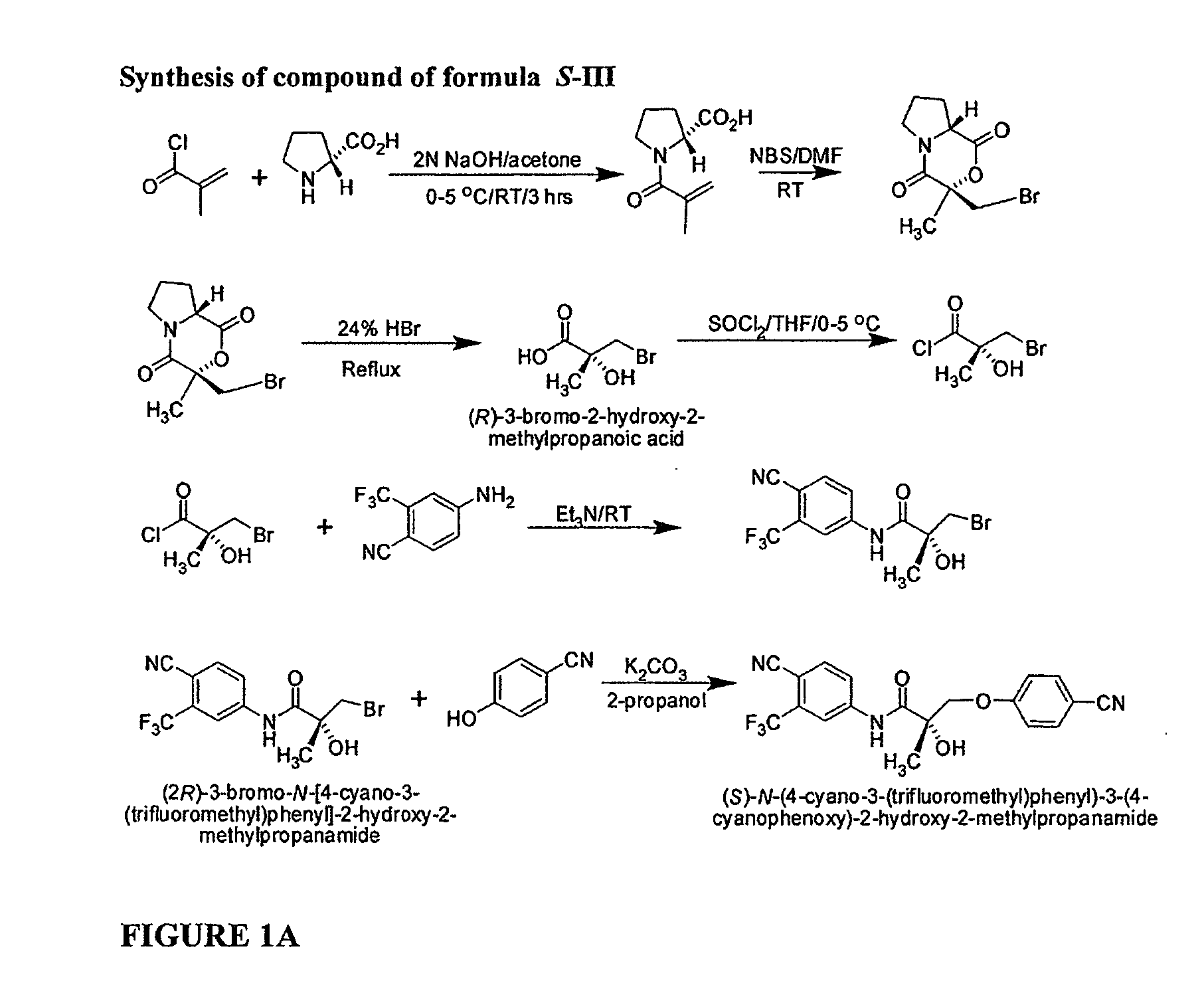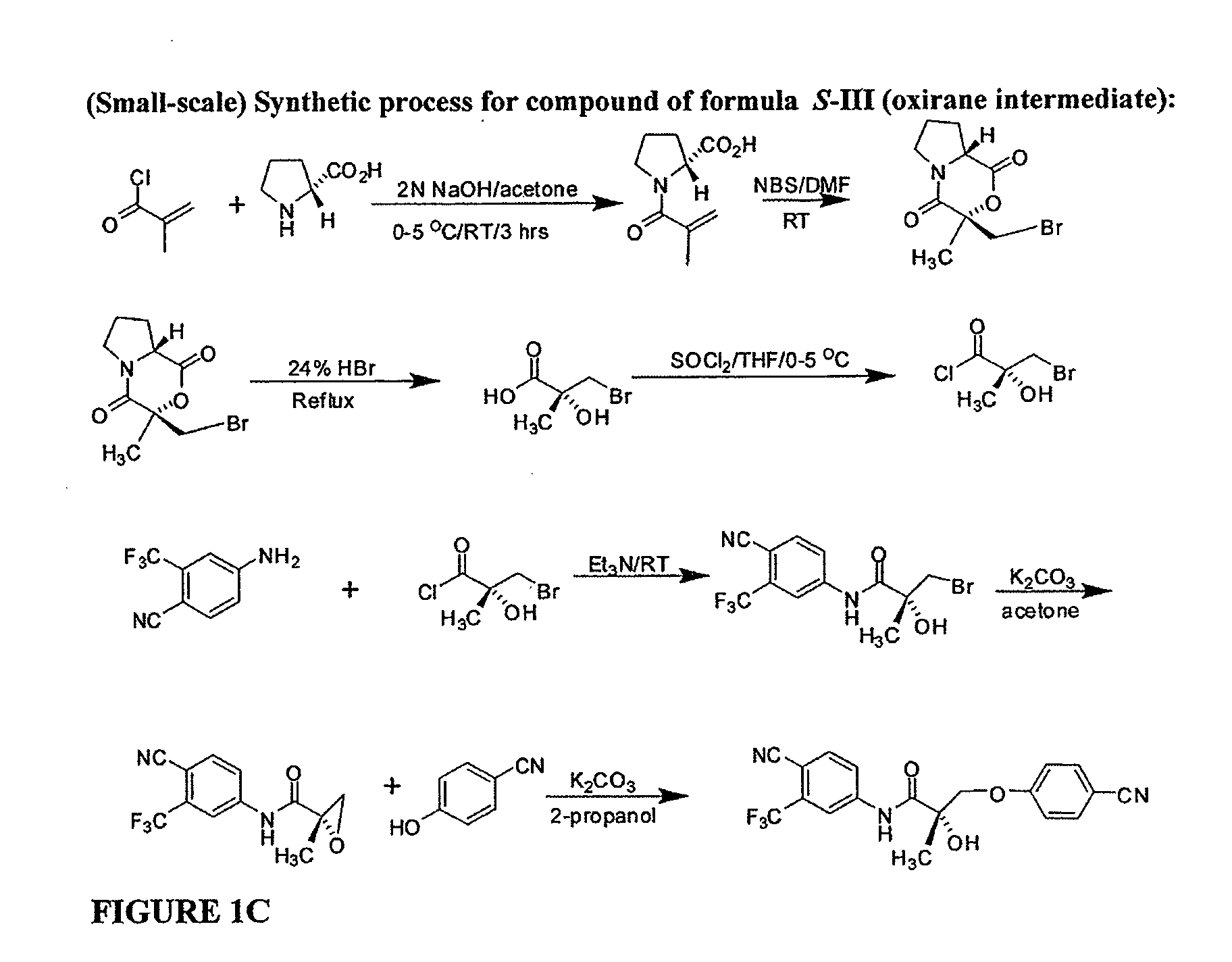Selective androgen receptor modulators for treating muscle wasting
- Summary
- Abstract
- Description
- Claims
- Application Information
AI Technical Summary
Benefits of technology
Problems solved by technology
Method used
Image
Examples
example 1
Synthesis of Compound V
[0966] Compound V was synthesized as described below, and as depicted in Scheme 1.
[0967] (2R)-1-Methacryloylpyrrolidin-2-carboxylic Acid (R-129). D-Proline (R-128, 14.93 g, 0.13 mol) was dissolved in 71 mL of 2 N NaOH and cooled in an ice bath; the resulting alkaline solution was diluted with acetone (71 mL). An acetone solution (71 mL) of metacryloly chloride 127 (13.56 g, 0.13 mol) and 2N NaOH solution (71 mL) were simultaneously added over 40 min to the aqueous solution of D-proline in an ice bath. The pH of the mixture was kept at 10-11° C. during the addition of the metacryloly chloride. After stirring (3 h, room temperature), the mixture was evaporated in vacuo at a temperature at 35-45° C. to remove acetone. The resulting solution was washed with ethyl ether and was acidified to pH 2 with concentrated HCl. The acidic mixture was saturated with NaCl and was extracted with EtOAc (100 mL×3). The combined extracts were dried over Na2SO4, filtered through...
example 2
Large Scale Synthesis of Compound V
[0974] Compound V (3-[4-(acetylamino)phenoxy]-2-hydroxy-2-methyl-N-[3-trifluoromethyl-4-nitrophenyl)-propanamide) is a member of the oxolutamide family of androgen receptor agonists, and is a nonsteroidal SARM. It binds the androgen receptor in vitro with high affinity (Ki=7.5±0.5 nM). In vivo it acts as a partial agonist at the androgen receptor and results in strong anabolic and weakly androgenic effects. Compound V has no other known endocrine activities.
[0975] Compound V was synthesized according to the following synthetic Steps:
Step 1—Synthesis of (2R)-1-Methacryloylpyrrolidin-2-carboxylic acid (R-129)
[0976]
[0977] A 72 L flask with a mechanical stirrer and inlet for inert atmosphere was set up in a cooling bath. The flask was placed under argon and charged with 5000 g (43.4 moles) of D-proline [ICN lot#7150E, ≧99%], 11.9 L of 4N NaOH, and 12 L acetone. The mixture was cooled to 5° C. on an ice bath. A solution of 4548.8 g (43.5 moles) of ...
example 3
Synthesis of (S) Enantiomer of Compound of Formula III
[0989]
[0990] (2R)-1-Methacryloylpyrrolidin-2-carboxylic Acid. D-Proline, 14.93 g, 0.13 mol) was dissolved in 71 mL of 2 N NaOH and cooled in an ice bath; the resulting alkaline solution was diluted with acetone (71 mL). An acetone solution (71 mL) of metacryloly chloride (13.56 g, 0.13 mol) and 2N NaOH solution (71 mL) were simultaneously added over 40 min to the aqueous solution of D-proline in an ice bath. The pH of the mixture was kept at 10-11° C. during the addition of the metacryloly chloride. After stirring (3 h, room temperature), the mixture was evaporated in vacuo at a temperature at 35-45° C. to remove acetone. The resulting solution was washed with ethyl ether and was acidified to pH 2 with concentrated HCl. The acidic mixture was saturated with NaCl and was extracted with EtOAc (100 mL×3). The combined extracts were dried over Na2SO4, filtered through Celite, and evaporated in vacuo to give the crude product as a co...
PUM
 Login to View More
Login to View More Abstract
Description
Claims
Application Information
 Login to View More
Login to View More - R&D
- Intellectual Property
- Life Sciences
- Materials
- Tech Scout
- Unparalleled Data Quality
- Higher Quality Content
- 60% Fewer Hallucinations
Browse by: Latest US Patents, China's latest patents, Technical Efficacy Thesaurus, Application Domain, Technology Topic, Popular Technical Reports.
© 2025 PatSnap. All rights reserved.Legal|Privacy policy|Modern Slavery Act Transparency Statement|Sitemap|About US| Contact US: help@patsnap.com



